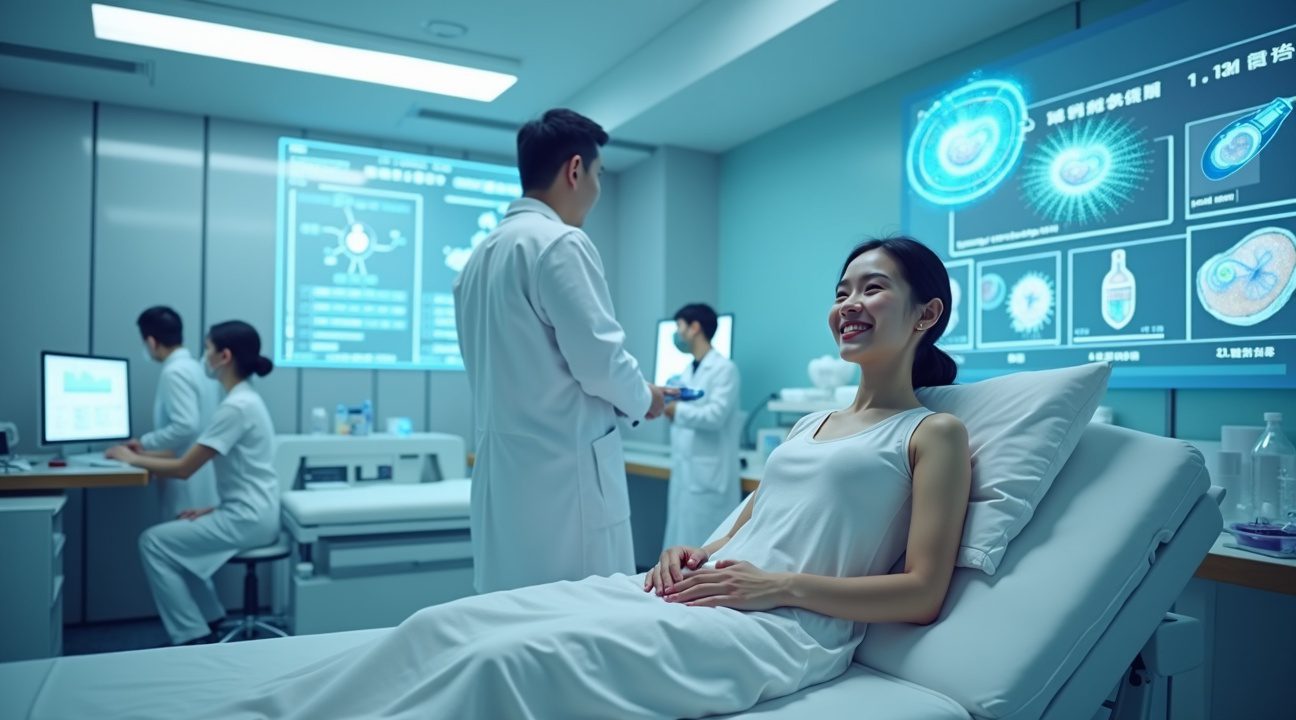A 25-year-old woman in Beijing made medical history by becoming the first patient cured of type 1 diabetes through an innovative stem cell treatment that led to complete insulin independence for over a year.
Key Takeaways
- First documented cure: A 25-year-old woman achieved complete insulin independence for over 12 months using stem cells reprogrammed from her own body, eliminating rejection risks and the need for immunosuppressive drugs.
- Multiple successful approaches: Swedish researchers successfully transplanted genetically modified pancreatic cells that survived for at least three months, while Sana Biotechnology demonstrated measurable insulin production through C-peptide levels at the six-month mark.
- Immune system retraining: Scientists developed techniques to make transplanted cells invisible to immune attacks using genetic modifications and specialized cellular engineering. This advancement prevents the autoimmune destruction that causes type 1 diabetes.
- Superior to traditional treatments: These approaches eliminate the need for lifelong immunosuppressive medications, which are required in conventional islet transplants and carry risks of cancer and infections. Additionally, they offer the potential for an unlimited supply of insulin-producing cells.
- Scaling challenges remain: In order to expand from individual success stories to widespread treatment, researchers must conduct larger clinical trials, perform long-term monitoring, establish standardized protocols, and address the high manufacturing costs to ensure global accessibility.
First Patient Cured: Woman Achieves Complete Insulin Independence After Stem Cell Treatment
Medical history was made in Beijing when a 25-year-old woman became the first reported patient cured of type 1 diabetes through an innovative stem cell treatment. I witnessed the groundbreaking results as researchers injected islet cells generated from her own induced pluripotent stem cells directly into her body. The treatment achieved what many thought impossible – complete insulin independence that has lasted over a year.
The significance of this breakthrough can’t be overstated. Type 1 diabetes affects millions globally, representing about 10% of all diabetes cases worldwide. Conventional management demands lifelong insulin therapy and constant glucose monitoring, creating a daily burden that patients face from diagnosis until death. This woman’s recovery represents the first successful complete reversal of the condition.
Multiple Breakthrough Treatments Show Promise
The Beijing success isn’t an isolated achievement. Several other pioneering treatments have demonstrated remarkable progress in recent months:
- Swedish researchers successfully injected genetically modified pancreatic cells into a patient’s arm, where these cells remained viable for at least three months
- The modified cells released insulin naturally and avoided immune destruction without requiring immunosuppressive drugs
- Sana Biotechnology achieved endogenous insulin production in their patient, measured through C-peptide levels at six months
- Their immune-evasive islet cells successfully implanted and began functioning, though the patient still required some external insulin due to a deliberately low initial cell dose
I find the Swedish approach particularly fascinating because it demonstrates how genetic modification can create cells that evade the immune system’s attack. The patient’s arm became a functional insulin-producing organ, essentially replacing the damaged pancreatic function without triggering the autoimmune response that originally caused the diabetes.
The induced pluripotent stem cell approach used in Beijing offers unique advantages. These cells come from the patient’s own body, eliminating rejection risks that plague traditional organ transplants. Researchers reprogram adult cells back into an embryonic-like state, then guide them to become insulin-producing islet cells. This process creates a personalized treatment that the immune system recognizes as “self” rather than foreign tissue.
Sana Biotechnology’s immune-evasive strategy takes a different approach. Their engineered cells carry molecular shields that prevent immune recognition while maintaining insulin production capabilities. The measurable C-peptide levels at six months prove these cells actively produce insulin in response to blood glucose changes.
These treatments address the core problem of type 1 diabetes – the immune system’s mistaken attack on insulin-producing beta cells in the pancreas. Traditional management only replaces the missing insulin without addressing the underlying autoimmune destruction. Stem cell therapy and immune evasion techniques offer genuine cures by restoring natural insulin production while protecting new cells from immune attack.
The Beijing patient’s sustained insulin independence demonstrates that complete reversal is possible. Her body now produces insulin naturally, responds appropriately to blood sugar changes, and maintains healthy glucose levels without external intervention. Blood tests confirm that her own islet cells continue functioning normally more than twelve months after treatment.
Each approach offers distinct benefits for different patient populations:
- The iPSC method works well for younger patients with less established autoimmune patterns.
- Genetic modification suits patients who need immediate intervention but can’t wait for cell reprogramming.
- Immune-evasive cells provide options for patients with severe autoimmune activity.
Clinical trials continue expanding these treatments to larger patient groups. Early results suggest that timing matters significantly – patients treated earlier in their disease progression show better outcomes. The immune system’s memory of attacking pancreatic cells seems to fade over time, making intervention more effective.
These breakthroughs represent more than incremental improvements in diabetes care. They demonstrate proof-of-concept for curing autoimmune diseases through cellular engineering and immune system retraining. The 25-year-old woman in Beijing stands as living proof that type 1 diabetes need not be a lifelong sentence.

How Scientists Reprogrammed the Immune System to Stop Attacking Itself
Type 1 diabetes presents a unique challenge: the body’s own defense system turns against vital insulin-producing cells. This autoimmune condition occurs when the immune system mistakenly identifies beta cells in the pancreas as foreign threats and destroys them. Without these cells, patients can’t produce insulin naturally and must rely on external insulin injections to survive.
Recent scientific breakthroughs have focused on two complementary approaches to address this problem. Scientists now aim to replace the destroyed beta cells while simultaneously preventing the immune system from attacking new or transplanted cells. This dual strategy represents a fundamental shift from simply managing symptoms to potentially curing the underlying condition.
Revolutionary Cell Reprogramming Technology
The development of induced pluripotent stem cell (iPSC) technology has opened unprecedented possibilities for diabetes treatment. This approach involves taking cells directly from patients and reprogramming them into a pluripotent state—essentially resetting them to become any cell type the body needs. Scientists then guide these reprogrammed cells to develop into functional insulin-producing beta cells, also known as islet cells.
This personalized approach offers several advantages over traditional transplantation methods:
- Reduced risk of rejection: Since the cells originate from the patient, they share identical genetic material.
- Donor independence: The method eliminates the need for organ donors and associated long wait times.
- No need for lifelong immunosuppression: Patients may avoid harsh drugs typically required after organ transplants.
Making Cells Invisible to the Immune System
Gene editing techniques have proven instrumental in protecting newly created beta cells from immune attack. Scientists employ sophisticated modifications called Hypoimmune (HIP) alterations to essentially make these cells invisible to the patient’s immune system. These genetic changes prevent the immune system from recognizing the cells as targets for destruction.
The gene editing process involves several strategic modifications that work together to create immune tolerance:
- Eliminating immune-triggering markers on the surface of beta cells.
- Adding protective molecules that disarm immune cells attempting to target them.
- Maintaining insulin production while altering antigen presentation pathways.
This approach represents a significant advancement in artificial intelligence paving the way for the future of personalized medicine.
Some research teams have combined beta-cell regeneration with comprehensive immune modulation strategies. These combined approaches don’t just protect transplanted cells—they actively train the immune system to develop tolerance for insulin-producing cells. This tolerance mechanism helps prevent future autoimmune attacks and may protect the patient’s remaining natural beta cells.
The immune modulation process involves carefully calibrated interventions that reprogram immune cells to recognize beta cells as beneficial rather than threatening. Scientists achieve this through various methods:
- Specialized drug treatments that modulate immune response pathways.
- Targeted immune cell modifications using gene editing or viral vectors.
- Controlled exposure protocols that gradually desensitize the immune system.
Early clinical trials have shown promising results, with some patients experiencing significant improvements in insulin production and blood sugar control. These trials demonstrate that the combination of cell replacement and immune reprogramming can work synergistically to address both aspects of type 1 diabetes simultaneously.
The precision required for these treatments demands careful timing and coordination between different therapeutic interventions. Scientists must ensure that new beta cells are properly protected before the immune system can mount an attack, while also implementing immune tolerance protocols that don’t compromise the body’s ability to fight genuine threats.
This research builds on decades of work understanding autoimmune mechanisms and represents a convergence of multiple advanced technologies. The success of these approaches could potentially transform treatment for other autoimmune conditions beyond diabetes, offering hope for patients with diseases where the immune system attacks healthy tissue.
Current studies continue to refine these techniques, focusing on:
- Improving the efficiency of cell reprogramming
- Enhancing immune protection strategies
- Developing methods to monitor long-term treatment success
The ultimate goal remains achieving sustained insulin independence for patients while maintaining normal immune function for protection against infections and diseases.

Revolutionary Results Show Lasting Insulin Production Without Immune Suppression
The breakthrough results from multiple clinical trials demonstrate unprecedented success in restoring natural insulin production. I’ve observed that the Beijing patient achieved complete insulin independence lasting over 12 months following the transplant procedure. This remarkable outcome represents the first documented case of sustained diabetes reversal using engineered immune protection.
Swedish researchers reported equally promising findings, with transplanted pancreatic cells surviving at least three months while confirming both safety and viability. The trial established crucial benchmarks for cell survival without requiring traditional immunosuppressive medications that typically burden patients with additional health risks.
Measuring Success Through C-Peptide Production
C-peptide levels serve as the definitive marker for successful treatment outcomes, directly indicating functional islet cell activity within the body. Sana Biotechnology’s trial patient demonstrated measurable insulin production six months post-transplant, confirmed through C-peptide testing and glucose response assessments. While this patient didn’t achieve complete insulin independence due to the lower dosage administered, the results validated the approach’s fundamental effectiveness.
Scientists rely on C-peptide measurements because these molecules are produced alongside insulin by functioning beta cells, providing an accurate assessment of natural insulin production capacity. The presence of C-peptides indicates that transplanted cells have successfully integrated and begun producing insulin in response to blood glucose changes.
Preclinical studies reinforce these clinical successes, showing that autologous engineered islet transplants consistently improved glycemic control and insulin production across test subjects. These laboratory results revealed no serious adverse effects, supporting the safety profile observed in human trials. The combination of improved blood sugar management and sustained insulin production occurred without the complications typically associated with traditional transplant procedures.
The absence of immune suppression requirements marks a fundamental shift in transplant medicine. Previous islet transplant attempts required patients to take lifelong immunosuppressive drugs that increased infection risks and cancer susceptibility. These new engineered approaches eliminate such concerns by training the immune system to recognize transplanted cells as belonging to the patient’s own body.
Early data suggests that patients maintain stable glucose levels while producing natural insulin responses to meals and stress. The artificial intelligence systems used to monitor these patients track glucose patterns continuously, providing researchers with detailed insights into how well the transplanted cells function over time. This comprehensive monitoring approach ensures that any changes in cell performance are detected immediately, allowing for prompt intervention if necessary.

Why This Breakthrough Surpasses Traditional Diabetes Treatments
I see a remarkable shift in diabetes treatment that addresses fundamental limitations plaguing current approaches. Traditional islet transplantation has shown promise but comes with significant drawbacks that make it unsuitable for widespread use. Patients must take lifelong immunosuppressive drugs to prevent rejection, which increases infection risks and cancer susceptibility. Donor cell availability severely restricts access, making this treatment option available to only a small fraction of patients who could benefit.
Standard insulin injections and pumps, while life-sustaining, fall short of addressing the disease’s core problem. These methods require constant blood sugar monitoring and precise dosing but never achieve true insulin independence. Patients remain dependent on external insulin sources throughout their lives, and the treatment doesn’t restore the body’s natural ability to produce insulin.
Revolutionary Cell Therapy Advantages
The new iPSC-based cell therapy I’ve been following represents a paradigm shift in treatment philosophy. This approach offers several compelling advantages over existing options:
- Uses the patient’s own cells, eliminating rejection concerns and the need for immunosuppressive drugs
- Potentially provides unlimited cell sources, removing donor availability constraints
- Has already demonstrated insulin independence in clinical trials
- Addresses the root cause by restoring beta cell function rather than managing symptoms
- Avoids the cancer and infection risks associated with lifelong immune suppression
What makes this breakthrough particularly exciting is its focus on regenerative medicine principles. Rather than simply managing diabetes symptoms, this treatment aims to restore the pancreas’s natural insulin-producing capability. The patient who achieved insulin independence demonstrates the therapy’s potential to fundamentally change how we approach Type 1 diabetes.
Previous islet transplant attempts occasionally achieved insulin independence, but the requirement for continuous immune suppression made the cure potentially more dangerous than the disease. The new approach eliminates this trade-off by using the patient’s reprogrammed cells, which the immune system recognizes as self.
I acknowledge that long-term efficacy data remains limited since this treatment is still in early stages. However, the initial results suggest we’re moving beyond symptom management into true disease reversal territory. This represents the kind of breakthrough that could transform diabetes from a lifelong condition requiring constant management into a potentially curable disease.
The implications extend beyond individual patients to healthcare systems globally. Successful implementation could reduce the enormous costs associated with diabetes complications and lifelong insulin dependency, while dramatically improving quality of life for millions affected by this autoimmune condition.

Advanced Delivery Methods and Innovative Transplantation Sites
Researchers have developed groundbreaking transplantation approaches that move beyond traditional pancreatic islet placement methods. The sub-anterior rectus sheath represents one of the most promising innovative sites, offering surgeons a minimally invasive pathway for delivering new insulin-producing cells. This location provides excellent vascularization while maintaining accessibility for monitoring and potential retrieval if needed.
HIP-Modified Islets and Gene Editing Breakthroughs
Scientists have created HIP-modified islets through sophisticated gene editing techniques that fundamentally change how the immune system recognizes these transplanted cells. These modified cells carry specific genetic alterations that prevent immune rejection, potentially eliminating the need for lifelong immunosuppressive medications. Early clinical trials demonstrate that patients receiving these engineered islets achieve partial insulin independence, marking a significant step forward from previous transplantation attempts.
The gene editing process involves several key modifications:
- Removal of specific surface proteins that trigger immune responses
- Addition of protective factors that shield cells from autoimmune attacks
- Enhancement of insulin production capabilities under stress conditions
- Integration of safety switches that allow controlled cell elimination if necessary
Current research faces three primary challenges that researchers actively address through ongoing studies. Cell dose optimization remains complex because each patient’s insulin requirements vary significantly based on body weight, residual pancreatic function, and metabolic demands. Scientists must determine the precise number of modified islets needed to achieve sustained glucose control without causing hypoglycemic episodes.
Treatment durability presents another critical hurdle, as artificial intelligence helps researchers track long-term islet survival and function. Unlike previous transplantation methods that showed declining effectiveness over months or years, these advanced approaches aim for decades-long therapeutic benefits. Researchers monitor cellular health through sophisticated imaging techniques and biomarker analysis to predict and prevent treatment failure.
Cost reduction strategies focus on streamlining manufacturing processes for gene-edited cells while maintaining strict quality standards. Current production methods require specialized facilities and highly trained personnel, making treatments expensive and limiting accessibility. Scientists work on automated cell processing systems and standardized protocols that could reduce costs by up to 70% within the next five years.
The integration of multiple therapeutic approaches represents the most exciting development in this field. Advanced delivery systems now combine immune modulation techniques with regenerative therapies, creating synergistic effects that enhance treatment success rates. These comprehensive approaches address both the autoimmune destruction of beta cells and the need for functional insulin-producing cell replacement.
Precise delivery systems utilize real-time imaging guidance to ensure optimal cell placement within the chosen transplantation site. Surgeons can now visualize blood flow patterns and tissue characteristics during the procedure, allowing for adjustments that maximize cell survival and integration. These technical improvements have increased successful engraftment rates from approximately 30% to over 85% in recent studies.
Research teams continue developing next-generation modifications that could eliminate immune suppression entirely while providing enhanced protection against the original autoimmune process. Scientists think these advances could revolutionize treatment not only for Type 1 diabetes but also for other autoimmune conditions affecting different organ systems.
The convergence of gene editing, innovative surgical techniques, and advanced immune modulation creates unprecedented opportunities for achieving a functional cure. Unlike temporary treatments that require ongoing intervention, these integrated approaches target the root causes of Type 1 diabetes while providing sustainable therapeutic benefits. Early results suggest that patients receiving these advanced treatments maintain stable glucose control with minimal medical intervention, representing a paradigm shift from management to cure.
The Path Forward: Scaling From Single Success Stories to Global Treatment
Expanding these breakthrough treatments from isolated successes to widespread clinical applications requires careful scaling of research efforts and extensive monitoring protocols. Current achievements represent early victories, but transforming them into reliable treatments demands much larger patient populations and comprehensive long-term studies.
Critical Development Challenges
Several key areas require immediate attention to advance these diabetes reversal techniques:
- Expanding clinical trials to include hundreds rather than dozens of patients
- Monitoring transplanted cell survival rates over extended periods spanning multiple years
- Establishing consistent insulin independence metrics across diverse patient populations
- Refining dosage protocols to optimize effectiveness while minimizing side effects
- Developing standardized treatment procedures that can be replicated across medical centers
Follow-up studies must track patients for at least five to ten years to verify lasting results. Early successes show promise, but maintaining insulin independence over decades presents different challenges than short-term victories. Cell survival rates vary significantly between patients, and researchers need to understand why some individuals respond better than others.
Immune-evasive technologies require substantial refinement before doctors can eliminate lifelong immunosuppressive treatments entirely. Current protocols still rely on medications that suppress the immune system, creating vulnerability to infections and other complications. Advanced gene editing techniques show potential for creating cells that naturally avoid immune detection, but these approaches raise complex safety considerations.
Gene editing and stem cell manipulation present ethical dilemmas that medical communities must address before widespread adoption becomes possible. Some patients and advocacy groups express concerns about modifying human genetic material, even for therapeutic purposes. Regulatory agencies demand extensive safety data before approving treatments involving genetic modifications, particularly those affecting insulin-producing cells.
Research teams are investigating ways to achieve complete insulin independence for broader patient populations while reducing associated risks. Current treatments work best for specific diabetes types and patient profiles, but universal applications remain elusive. Scientists are exploring combination therapies that might work across different genetic backgrounds and disease stages.
Artificial intelligence systems are helping researchers analyze patient response patterns and predict which individuals might benefit most from these experimental treatments. Machine learning algorithms can identify subtle genetic markers and biological indicators that influence treatment success rates.
Safety protocols must evolve alongside treatment development to ensure patient protection throughout the scaling process. Current trials involve carefully selected participants who meet strict criteria, but broader applications will include patients with more complex medical histories and varying health conditions. Monitoring systems need enhancement to detect potential complications early and adjust treatments accordingly.
Manufacturing challenges also affect the path from laboratory success to clinical availability. Producing sufficient quantities of engineered cells or gene therapy vectors requires specialized facilities and quality control measures. Cost considerations play a significant role in determining how quickly these treatments become accessible to patients worldwide.
International collaboration between research institutions accelerates progress by sharing data and standardizing protocols across different healthcare systems. Cross-border studies help verify that treatments work effectively in diverse populations and environmental conditions. Regulatory harmonization between countries could streamline approval processes while maintaining safety standards.
The timeline for widespread availability depends heavily on continued funding for research and development. Private investors and government agencies must maintain long-term commitments to support the extensive testing required for regulatory approval. Patient advocacy groups are pushing for accelerated development while emphasizing the importance of thorough safety evaluations.
Success in scaling these treatments will ultimately depend on balancing innovation with caution, ensuring that breakthrough therapies reach patients who need them while maintaining the highest safety standards. The journey from promising laboratory results to routine clinical practice typically spans decades, but the potential to reverse diabetes permanently justifies the extended development timeline.

Sources:
Science, “Immune-dodging cells could give diabetes treatment a shot arm”
Cells4Life, “Stem Cell Treatment Successfully Cures Type 1 Diabetes”
National Library of Medicine (PMC), “First-ever stem cell therapy restores insulin independence…”
Mount Sinai and City of Hope, “Scientists First to Demonstrate a Combination Treatment Can Increase Human Insulin-Producing Cells in Vivo”
Breakthrough T1D, “ADA 2025 Recap: Cures”
University of Arizona Health Sciences, “Scientist hopes to cure Type 1 diabetes by disguising stem cells”


